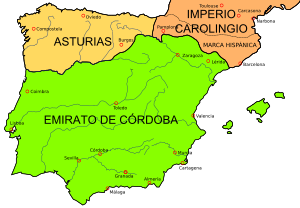Battle of Las Babias facts for kids
Quick facts for kids Battle of Las Babias |
|||||||
|---|---|---|---|---|---|---|---|
| Part of Razias of Hirsham I the Reconquista |
|||||||
 A map of the Iberian Peninsula around the time of the conflict. |
|||||||
|
|||||||
| Belligerents | |||||||
| Emirate of Córdoba | |||||||
| Commanders and leaders | |||||||
| Hisham I of Córdoba Abd al-Karim ibn Abd al-Wahid ibn Mugit Farach ibn Kinanah |
|||||||
| Strength | |||||||
| Unknown | 10,000 | ||||||
| Casualties and losses | |||||||
| Unknown | Unknown | ||||||
The Battle of Las Babias happened in the year 795. It was a fight between the Kingdom of Asturias and the Emirate of Córdoba. The leader of Córdoba, Hisham I of Córdoba, wanted to get revenge for earlier defeats his army faced in 794. These earlier battles had caused big losses for Córdoba. The Battle of Las Babias ended with a victory for Córdoba.
Contents
Why the Battle of Las Babias Happened
The leader of Córdoba, called an Emir, Hisham I of Córdoba, wanted revenge. His army had been defeated in 794 at the Battle of Lutos. In that battle, a general from Córdoba was killed. To get his revenge, Emir Hisham I sent his brother, Abd al-Karim ibn Abd al-Walid ibn Mugaith, with an army of 10,000 soldiers. Their mission was to attack the Kingdom of Asturias.
The Emir also sent another army to the Kingdom of Galicia. This was to distract Christian forces and stop them from helping Asturias. This second army went into Galicia and caused a lot of damage. When they were leaving, they fought against forces from Galicia and Asturias. The Muslim army was defeated and lost many soldiers, but they eventually managed to escape.
King Alfonso II of Asturias prepared his army near Astorga. This area was often used by Muslim armies to attack Asturias. King Alfonso II sent the local people into the nearby mountains for safety. He then waited for the Córdoban army to attack him. The location was good because it allowed his army a safe way to retreat if needed.
What Happened During the Battle
Abd al-Karim sent his first group of 4,000 soldiers to attack King Alfonso II's main army. This group was led by Farach ibn Kinanah. Abd al-Karim himself followed shortly after with the rest of his army. Their combined forces managed to defeat the Asturian army. As planned, the Asturians retreated while fighting to slow down the Córdoban cavalry that was chasing them.
What Happened After the Battle
After this battle, Abd al-Karim ibn Abd al-Walid ibn Mugaith and Farach ibn Kinanah went on to defeat the Asturian forces in other battles. These included the Battle of Río Quirós and the Battle of Río Nalón. They even captured the city of Oviedo in the Battle of Oviedo.
When winter arrived, the Córdoban armies went back to their own lands. They did not completely defeat the Kingdom of Asturias. King Alfonso II of Asturias and his army were able to escape.
Soon after, Emir Hisham I of Córdoba died. There were disagreements among his sons about who should rule next. This gave the Kingdom of Asturias time to recover from their defeats. King Alfonso II of Asturias also used this time to form an alliance with Charlemagne, who was the King of the Franks.
See also
 In Spanish: Batalla de las Babias para niños
In Spanish: Batalla de las Babias para niños

